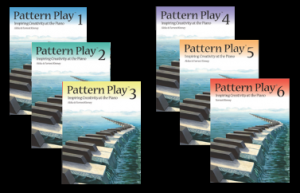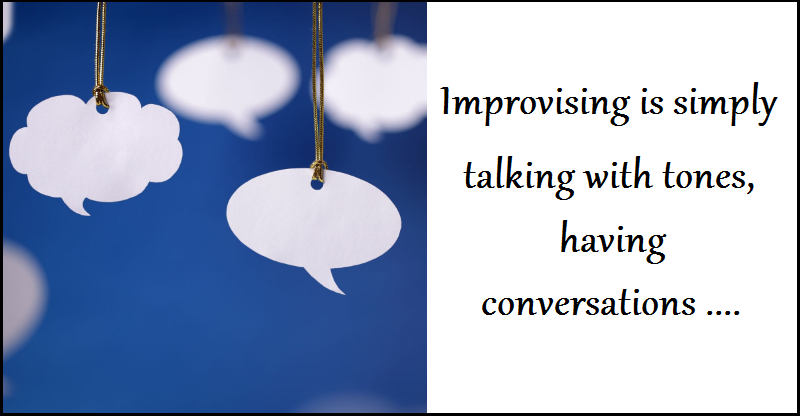Pattern Play with Forrest Kinney
A conversation with Forrest Kinney about Pattern Play, improvisation, and how to use it in our studios…
I am always excited to look for new ways to inject enthusiasm into piano lessons. As a classical pianist, I rarely had time to devote to improvisation skills, or really just ‘noodle’ around on the piano. Our studio decided to check these books out and I loved the books so much that I ordered all six of them. I’ve been using them with my students with great success. Whenever we have a few minutes and I ask them what they would like to do, they invariably say, “Pattern Play!!” One student even asked me: “Can we just do Pattern Play for hours and hours and hours?”
We are delighted to have Forrest Kinney visit the-piano-studio.com to join us for our Conversations series, in which we talk with various piano luminaries and chat about their areas of expertise. It was nice to get an inside look at the series…
Pattern Play with Forrest Kinney
1) Can you give a brief overview of Pattern Play?
Pattern Play is essentially an approach to improvisation. My various Pattern Play books have been centered on the piano (because that’s my instrument), but the approach can be transferred to other instruments.
The general idea is this: You learn a relatively simple repeating accompaniment called a Pattern (it can consist of even a single bass note for beginners) and a contrasting accompaniment pattern called a Vacation. Then you add improvised melodies and sounds to these using a given set of notes (such as all the black keys).
This simple approach applies to any musical style, not merely jazz and blues. In my books, you “pattern play” with Persian scales, in African rhythms, with Debussy-like sounds, with tango rhythms, and many other styles.
In the Pattern Play series published by Frederick Harris, the pieces generally become more challenging to play as solos as you advance through the books, but inexperienced students can often play the pieces as duets with the teacher even in the later books.
2) What inspired you to develop this series?
Traditionally, improvisation was taught after one learned to play tunes, understood harmony enough to make accompaniments, and played at an intermediate level or above. Improvisation then consisted of making variations on tunes, particularly on the repeats. However, this approach meant that those students in the beginning years of study were not encouraged to improvise. So, by the time they were ready, most people were so fixed to the page they found it difficult to explore without crippling self-criticism.
What we have needed in our tradition (for centuries!) is an approach to improvisation that can be done from the first lesson onward. I wanted to create such an approach. I developed the approach based upon two things: 1) how I instinctively taught myself to improvise when I was a teenager and 2) the pattern-based approach that my jazz teacher used when I finally took jazz lessons in my late twenties.
3) There has always seemed to be a dividing line between pianists that are trained to read and those that can play by ear or improvise. How does your Pattern Play series address that issue?
When people are encouraged to explore freely with sounds from the first lesson, they do not feel bound to the page. And so, such a person can learn to read and still be able to improvise.
By the way, I make a distinction between improvising and playing by ear. A person can be a fine improviser but lousy at playing tunes by ear—this was the case with me and still is to some degree. Likewise, a person can be very good at playing tunes by ear but not comfortable improvising. Because these two different skills are both distinct from reading, they tend to be lumped together. The Pattern Play approach develops the ability to improvise, but not so much the ability to play tunes by ear—a different but related skill that is the foundation of the art of arranging. That skill is explored in my Chord Play series.
4) What do you want to say to those who think they can’t improvise?
I say, “Are you able to talk and have conversations with words?” When the person answers “yes,” I then say, “Improvising is simply talking with tones, having conversations. Reading music is like reading and reciting a script. You just have to learn to talk with tones, that’s all.” And then I have a musical conversation with them by playing a duet.
5) What are some of the skills that you hope students/teachers will take away from using these books?
Above all, the ability to play spontaneously from one’s own feelings. To play in an intuitive and personal way. To be able to listen deeply to tones from the beginning, and RESPOND to them. That is the essence of musical artistry: listening and responding. With Pattern Play, we can teach these essential skills and sensitivities from the first lesson onward.
6) Do you have specific suggestions on how teachers should introduce and use Pattern Play in their studios and how to adapt it to students of different abilities?
Yes. The Duet-to-Solo Approach. Play a duet with the student first. Create a safe, rich, welcoming environment, and then say, “Play with me on black keys.” Or “Play with me in the key of A Minor.” Then the student feels safe enough to begin exploring. When the student is successful, the teacher says, “I want to play the top part!” The student learns a left hand accompaniment while the teacher improvises. Then the student starts to bring the hands together. All the while the teacher is playing with the student, not standing above them or observing them. This approach has been the key. That’s why my recent books all start with Duets. Some students will not be ready to play solo for quite a while, but all students can play duets.
7) Are there some general pointers that you can offer to those who are doing the creative part of Pattern Play duets? Those that are doing the pattern side?
Both sides should be creative! The person playing the Pattern on the bottom should be listening and responding, varying the Pattern in response to what the top person is doing. The bottom person is not an accompaniment but a co-creator. I recommend that the top person close their eyes and respond, and not look at a page or try to analyze what the bottom person is doing. Then the response becomes intuitive and creative.
8) Which is(are) your favourite pattern(s)? Is there a story behind it?
My favorite Patterns are Blues on Black (Pattern Play 1 published by Frederick Harris Music), Reflecting (same book), and Persia (same book). I have so many stories to tell with each of these Patterns, so many rich experiences. For example, I once played Blues on Black with Bill Gates at his home when I was hired to play there at a Christmas party!
9) What other things can students do to develop and improve their improvisation skills?
The main thing is play Patterns in diverse styles. And then transpose favorite Patterns to other keys. And keep exploring.
10) Is anything coming down the pipeline for the Pattern Play series?
Well, I’m glad you asked! I just finished the first entirely new Pattern Play series in seven years. It’s called Create First!—Learning Music the Pattern Play Way.
This series has a lot of new features. There is now a Duet book for teachers to use in the lesson and a Solo book for students to use at home. Each piece in each book has a companion video. (I just finished making 111 videos!) Each book can be sold as a PDF so I can now easily send Pattern Play around the world. And the series is designed to introduce musicality, scales, intervals, and chords in a musical and creative way. I’m thrilled with how this new series turned out.
11) How can we find out more about your work?
I have a website: www.forrestkinney.com. There is a lot of information there about not only Pattern Play, but what I call the Four Arts of Music: improvising, arranging, composing, and interpreting. You can find out more about my books on the Shop page. You can also write me with questions at: forrestkinney@yahoo.com
Thanks for the excellent questions!
About Forrest Kinney
 Forrest Kinney has taught music for four decades. His goal is to help others become creative, whole musicians capable of enjoying improvising, arranging, composing, and interpreting. He is the author of Pattern Play and Chord Play, well-loved series on improvisation and arranging at the piano.
Forrest Kinney has taught music for four decades. His goal is to help others become creative, whole musicians capable of enjoying improvising, arranging, composing, and interpreting. He is the author of Pattern Play and Chord Play, well-loved series on improvisation and arranging at the piano.
Forrest is a performer, professional arranger, composer, writer, and frequent presenter at conferences and public events. He lives east of Seattle, Washington.

